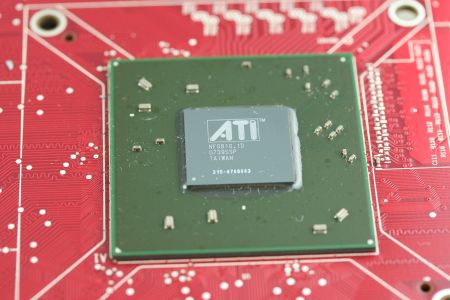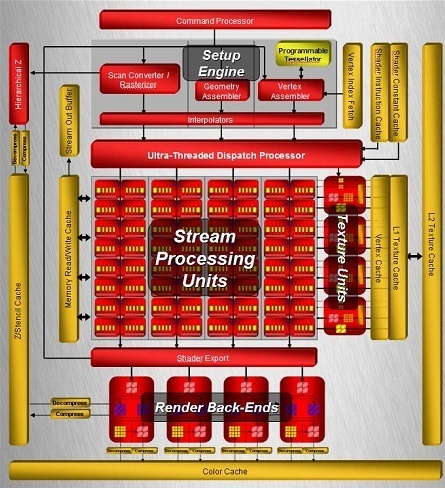AMD Radeon HD 3800: ATI Strikes Back
Radeon HD 3000: A New Architecture?
Contrary to what their name may imply, let's right away cut through the marketing smoke screen, which AMD couldn't resist to pull once more; no, the Radeon HD 3000 does not introduce a new architecture at all, neither is it an important evolution compared to the Radeon HD 2900. Those cards' name should have started with Radeon HD 2xxx and nothing else (as did the Radeon 1900 in its time, and even they were a bigger evolution), and it's disappointing to see to what extent the company has a tendency to rely on this kind of method every time it's in a difficult position, just as it did in other areas at the time of the Radeon HD 2900 presentation. Moving on.
The RV670
As with the GeForce 8800 GT, the Radeon HD 3800 was only made possible thanks to the improvement in process. And at this game, AMD still has the lead since it goes down from 80 nm to 55 nm, whereas NVIDIA wasn't able to go beyond 65 nm. It must be said that the Canadians' job was, it seems, not as difficult at least from a numerical point of view, with 666 million transistors for this new chip versus, if you remember, 754 million on the G92 of the 8800 GT. Thus, contrary to NVIDIA, the number of transistors is decreasing compared to the previous chip, as the R600 totaled 700 million transistors.
A GPU that doesn't evolve much
Yet, the number of computational units remains unchanged (when it was slightly decreasing with NVIDIA) with 320 stream processors. There are still only 16 texturing units (what a shame not to take the opportunity to correct this limitation!) and 16 ROP. The only enhancements: An optimization of the memory controller, in charge of making a better usage of the bandwidth, the manufacturer goes so far as to claim similar performance to a Radeon HD 2900 at identical frequencies, despite a memory interface limited to 256 bits (the ring bus displaying 512 bits or 2 x 256 bits to be precise). PCI Express 2.0 support is also making its debut, but it should only show a slight gain with cards limited by the quantity of memory (HyperMemory cards or the HD 3850 256 MB), and in high resolution, except, of course, in GPGPU applications. Also on stage, the UVD, yet absent from the HD 2900 XT if you recall, but the GeForce 8800 GT gaining back PureVideo 2, the Canadian didn't have a choice and it's all for the best. The support of DirectX 10.1 is also to be considered, even if the Radeon HD 2000 were already quite close to it.
PowerPlay Is No Longer Reserved To Notebooks
Here's a good concept! We had regretted that technologies significantly decreasing power consumption in certain situations were only reserved to components meant for laptops, whether it is for CPUs, GPUs, chipsets and others. AMD steps up by enabling the activation of the PowerPlay of the Radeon Mobility on the HD 3800.
Get Tom's Hardware's best news and in-depth reviews, straight to your inbox.
Practically, the mode corresponding to the "maximum battery" setting should make its appearance. This simply reduces GPU and memory frequencies to intermediate values between those in idle and peak. Yet such a mode remains questionable on a Desktop. Another problem, the actual drivers don't enable any page dedicated to PowerPlay management and our tests under 2D and light 3D didn't reveal any automatic intermediate mode. Thus, here's again another failed promise by AMD...
Current page: Radeon HD 3000: A New Architecture?
Prev Page Direct3D 10.1: Quality, Practically Next Page Triple And Quad CrossFire, Specifications
